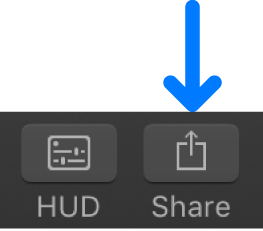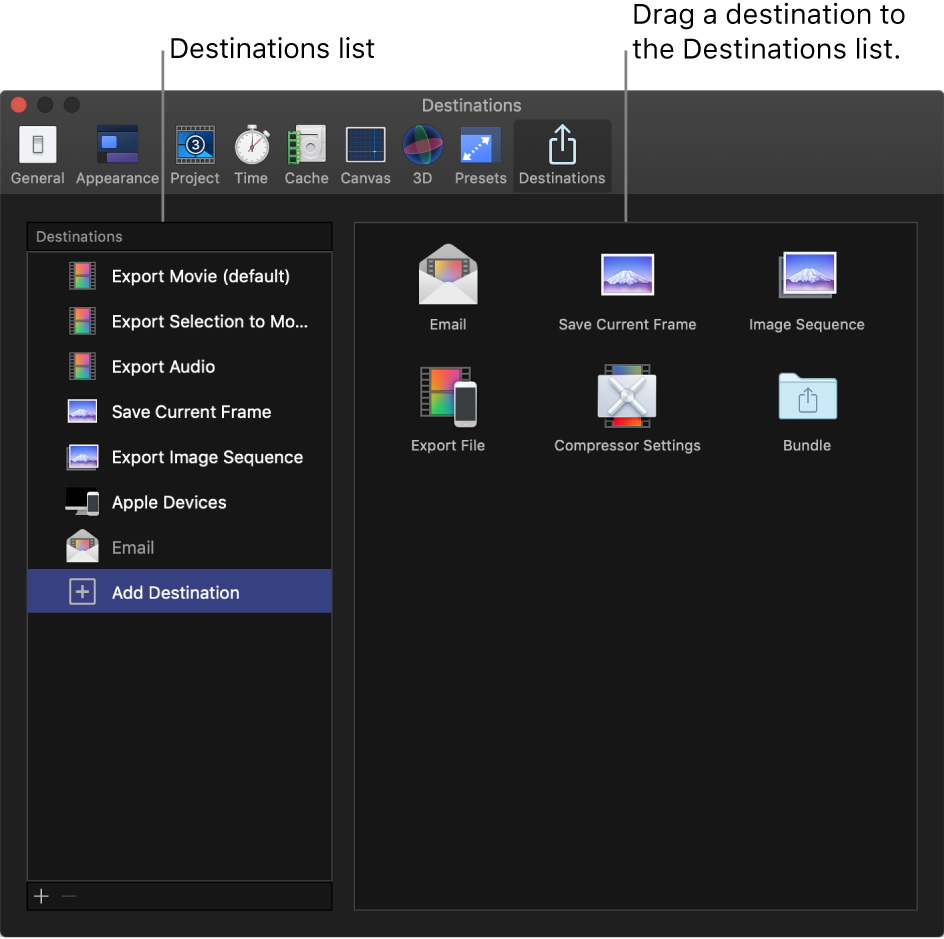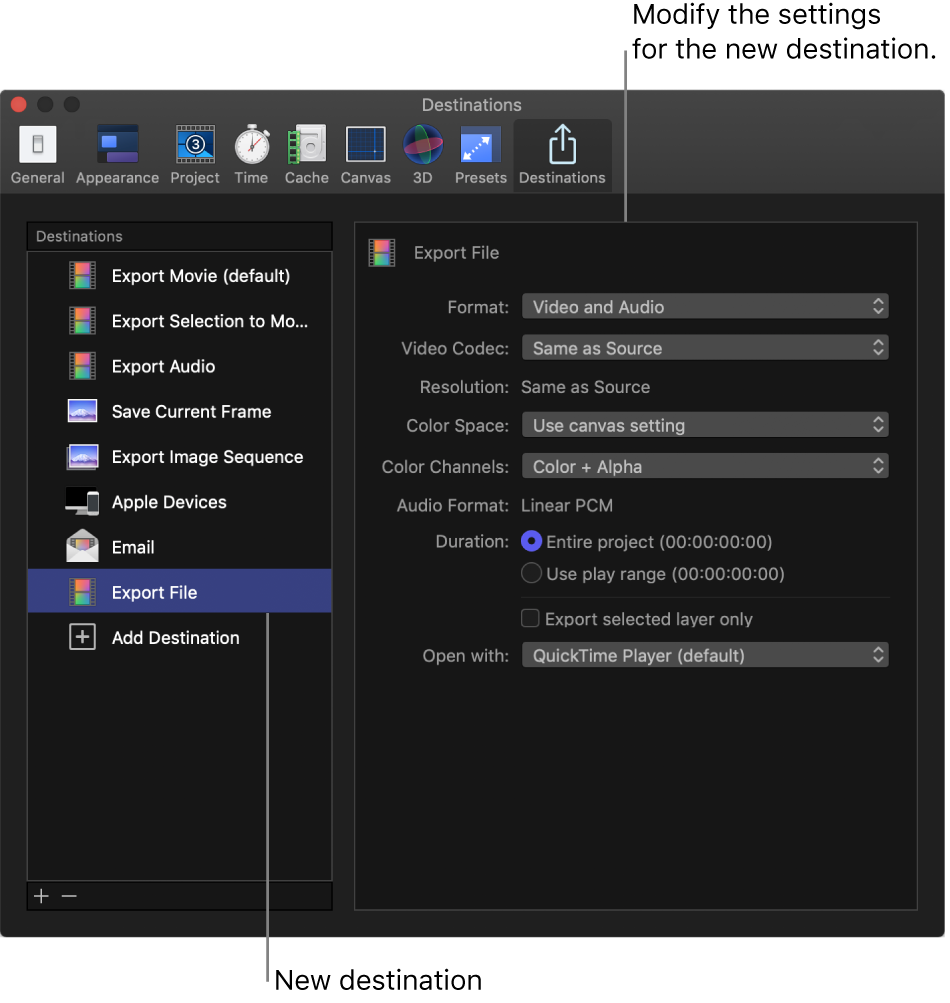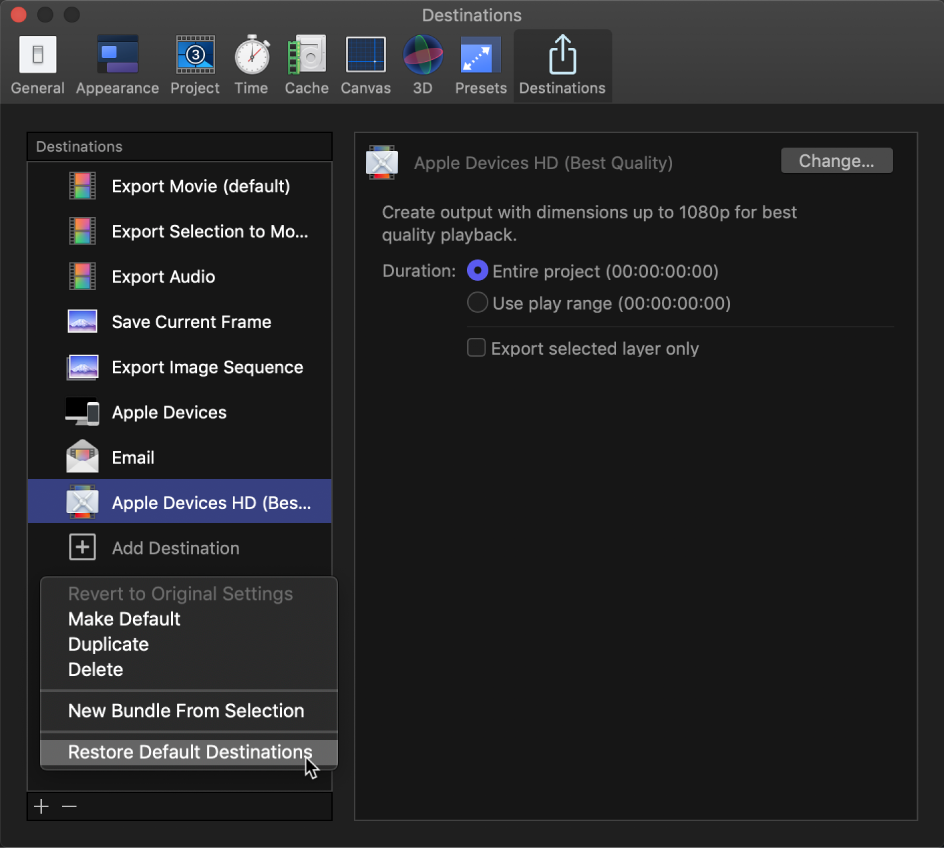Motion User Guide
- Welcome
-
- Intro to basic compositing
-
- Intro to transforming layers
-
- Intro to transforming layers in the canvas
- Transform layer properties in the canvas
- Transform tools
- Change layer position, scale, or rotation
- Move a layer’s anchor point
- Add a drop shadow to a layer
- Distort or shear a layer
- Crop a layer
- Modify shape or mask points
- Transform text glyphs and other object attributes
- Align layers in the canvas
- Transform layers in the HUD
- Transform 2D layers in 3D space
-
- Intro to behaviors
- Behaviors versus keyframes
-
- Intro to behavior types
-
- Intro to Parameter behaviors
- Audio behavior
- Average behavior
- Clamp behavior
- Custom behavior
- Add a Custom behavior
- Exponential behavior
- Link behavior
- Logarithmic behavior
- MIDI behavior
- Add a MIDI behavior
- Negate behavior
- Oscillate behavior
- Create a decaying oscillation
- Overshoot behavior
- Quantize behavior
- Ramp behavior
- Randomize behavior
- Rate behavior
- Reverse behavior
- Stop behavior
- Track behavior
- Wriggle behavior
-
- Intro to Simulation behaviors
- Align to Motion behavior
- Attracted To behavior
- Attractor behavior
- Drag behavior
- Drift Attracted To behavior
- Drift Attractor behavior
- Edge Collision behavior
- Gravity behavior
- Orbit Around behavior
- Random Motion behavior
- Repel behavior
- Repel From behavior
- Rotational Drag behavior
- Spring behavior
- Vortex behavior
- Wind behavior
- Additional behaviors
-
- Intro to using generators
- Add a generator
-
- Intro to image generators
- Caustics generator
- Cellular generator
- Checkerboard generator
- Clouds generator
- Color Solid generator
- Concentric Polka Dots generator
- Concentric Shapes generator
- Gradient generator
- Grid generator
- Japanese Pattern generator
- Lens Flare generator
- Manga Lines generator
- Membrane generator
- Noise generator
- One Color Ray generator
- Op Art 1 generator
- Op Art 2 generator
- Op Art 3 generator
- Overlapping Circles generator
- Radial Bars generator
- Soft Gradient generator
- Spirals generator
- Spiral Drawing generator
- Use Spiral Drawing onscreen controls
- Star generator
- Stripes generator
- Sunburst generator
- Truchet Tiles generator
- Two Color Ray generator
- Save a modified generator
-
- Intro to filters
- Browse and preview filters
- Apply or remove filters
-
- Intro to filter types
-
- Intro to Color filters
- Brightness filter
- Channel Mixer filter
- Color Balance filter
- Example: Color-balance two layers
- Color Curves filter
- Use the Color Curves filter
- Color Reduce filter
- Color Wheels filter
- Use the Color Wheels filter
- Colorize filter
- Contrast filter
- Custom LUT filter
- Use the Custom LUT filter
- Gamma filter
- Gradient Colorize filter
- HDR Tools filter
- Hue/Saturation filter
- Hue/Saturation Curves filter
- Use the Hue/Saturation Curves filter
- Levels filter
- Negative filter
- OpenEXR Tone Map filter
- Sepia filter
- Threshold filter
- Tint filter
-
- Intro to Distortion filters
- Black Hole filter
- Bulge filter
- Bump Map filter
- Disc Warp filter
- Droplet filter
- Earthquake filter
- Fisheye filter
- Flop filter
- Fun House filter
- Glass Block filter
- Glass Distortion
- Insect Eye filter
- Mirror filter
- Page Curl filter
- Poke filter
- Polar filter
- Refraction filter
- Ring Lens filter
- Ripple filter
- Scrape filter
- Sliced Scale filter
- Use the Sliced Scale filter
- Sphere filter
- Starburst filter
- Stripes filter
- Target filter
- Tiny Planet filter
- Twirl filter
- Underwater filter
- Wave filter
-
- Intro to Stylize filters
- Add Noise filter
- Bad Film filter
- Bad TV filter
- Circle Screen filter
- Circles filter
- Color Emboss filter
- Comic filter
- Crystallize filter
- Edges filter
- Extrude filter
- Fill filter
- Halftone filter
- Hatched Screen filter
- Highpass filter
- Indent filter
- Line Art filter
- Line Screen filter
- MinMax filter
- Noise Dissolve filter
- Pixellate filter
- Posterize filter
- Relief filter
- Slit Scan filter
- Slit Tunnel filter
- Texture Screen filter
- Vignette filter
- Wavy Screen filter
- Publish filter parameters to Final Cut Pro
- Using filters on alpha channels
- Filter performance
- Save custom filters
-
- Intro to 3D objects
- Add a 3D object
- Move and rotate a 3D object
- Reposition a 3D object’s anchor point
- Exchange a 3D object file
- 3D object intersection and layer order
- Using cameras and lights with 3D objects
- Save custom 3D objects
- Guidelines for working with 3D objects
- Working with imported 3D objects
-
- Intro to 360-degree video
- 360-degree projects
- Create 360-degree projects
- Add 360-degree video to a project
- Create a tiny planet effect
- Reorient 360-degree media
- Creating 360-degree templates for Final Cut Pro
- 360-degree-aware filters and generators
- Export and share 360-degree projects
- Guidelines for better 360-degree projects
-
-
- Intro to preferences and shortcuts
-
- Intro to Keyboard shortcuts
- Use function keys
- General keyboard shortcuts
- Audio list keyboard shortcuts
-
- Tools keyboard shortcuts
- Transform tool keyboard shortcuts
- Select/Transform tool keyboard shortcuts
- Crop tool keyboard shortcuts
- Edit Points tool keyboard shortcuts
- Edit shape tools keyboard shortcuts
- Pan and Zoom tools keyboard shortcuts
- Shape tools keyboard shortcuts
- Bezier tool keyboard shortcuts
- B-Spline tool keyboard shortcuts
- Paint Stroke tool keyboard shortcuts
- Text tool keyboard shortcuts
- Shape mask tools keyboard shortcuts
- Bezier Mask tool keyboard shortcuts
- B-Spline Mask tool keyboard shortcuts
- Transport control keyboard shortcuts
- View option keyboard shortcuts
- HUD keyboard shortcuts
- Inspector keyboard shortcuts
- Keyframe Editor keyboard shortcuts
- Layers keyboard shortcuts
- Library keyboard shortcuts
- Media list keyboard shortcuts
- Timeline keyboard shortcuts
- Keyframing keyboard shortcuts
- Shape and Mask keyboard shortcuts
- 3D keyboard shortcuts
- Miscellaneous keyboard shortcuts
- Touch Bar shortcuts
- Move assets to another computer
- Work with GPUs
- Glossary
- Copyright

Create and modify share destinations in Motion
In the Destinations pane of the Motion Preferences window, you can add new destinations, modify existing destinations, delete destinations, and create destination bundles, which allow you to export multiple types of output at once. You can also revert to the default set of destinations that were available when you first opened Motion.

For information about sharing projects and clips from Motion, see Intro to sharing Motion projects.
Create a new destination
In Motion, do one of the following:
Choose File > Share > Add Destination.
Choose Motion > Preferences, click Destinations at the top of the window, then select Add Destination in the list on the left.
On the right side of the toolbar, click Share, then choose Add Destination.

In the Destinations pane of the Preferences window, do one of the following:
Drag a destination from the area on the right to the Destinations list on the left (or double-click a destination on the right).

Control-click a destination in the list on the left, then choose Duplicate.
The new destination appears selected in the list on the left, and the settings for the destination appear on the right.
Specify settings for the new destination.

For descriptions of the controls in each destination, see Intro to Destinations preferences in Motion. For information on using each default destination, see the previous topics in this chapter.
Here are some tips for setting up various types of destinations:
Use the Export File destination to export a movie, a single layer as a movie, or an audio file, or if you want to share to Apple devices. Choose an option from the Format pop-up menu in the Export File settings.
Rename the new destination to better describe its settings by double-clicking its name in the Destinations list, typing a new name, then pressing Return.
If you chose the Compressor Settings destination, select a Compressor setting (or select multiple Compressor settings) in the window that appears, then click OK. The settings that are displayed include the Compressor settings that come with Motion as well as any settings you added.
Important: You can use the Compressor Settings destination only if you have Compressor installed or someone gives you a Compressor setting.
Close Motion Preferences.
When you choose File > Share, or click Share on the right side of the toolbar, your new destination appears in the list.
You can make changes to the destination at any time. As you customize the destination, your changes are saved automatically.
Modify existing destinations
Choose Motion > Preferences, then click Destinations at the top of the window.
The Destinations pane appears, with a list of destinations on the left.
Do any of the following:
Change a destination’s settings: Select a destination, then modify the destination’s settings on the right.

Restore a destination to its original settings: Control-click a destination in the Destinations list, then choose Revert to Original Settings.
Rename a destination: Double-click a destination in the list on the left, then type a new name.
Change the order of destinations in the list: Drag a destination to a different location in the list.
For descriptions of the controls in each destination, see Intro to Destinations preferences in Motion. For information on using each default destination, see the previous topics in this chapter.
As you modify destinations, your changes are saved automatically.
Create a bundle of destinations
Bundles make it easy to create several types of output in a single step. A bundle holds a set of destinations. When you share a project using the bundle, a file is output for each destination in the bundle.
Choose Motion > Preferences, then click Destinations at the top of the window.
Select Add Destination in the Destinations list, then double-click the Bundle destination (or drag it from the area on the right to the Destinations list on the left).
An empty bundle appears in the Destinations list.
To add destinations to the bundle, drag existing destinations into it from the Destinations list, or select Add Destination and drag destinations from the area on the right into the bundle.
Tip: To quickly make a bundle from destinations in the Destinations list, select one or more destinations in the list, then Control-click in the Destinations list and choose New Bundle from Selection.
Delete a destination
Choose Motion > Preferences, then click Destinations at the top of the window.
Do one of the following:
Control-click a destination in the Destinations list, then choose Delete.
Select a destination in the Destinations list, then press Delete.
Select a destination in the Destinations list, then click the Remove button (–) below the list.
Assign a default destination
Choose Motion > Preferences, then click Destinations at the top of the window.
Control-click the destination or bundle you want to make the default, then choose Make Default.
The name of the new default destination is appended with “(default).”
After you set the default destination, you can quickly share to that destination by pressing Command-E. To use the Command-E keyboard shortcut to share to another destination (or destination bundle), you can make that destination or bundle the default.
Revert to the set of destinations that came with Motion
Choose Motion > Preferences, then click Destinations at the top of the window.
Control-click an empty area in the list on the left, then choose Restore Default Destinations from the shortcut menu.

Any custom destinations are deleted, and the default set of destinations appears. For a list of the default destinations, see Intro to sharing Motion projects.
Share destinations between Motion users
Choose Motion > Preferences, then click Destinations at the top of the window.
Do any of the following:
Export destinations from your copy of Motion: Drag one or more destinations from the Destinations list to a location in the macOS Finder.
The destination file is appended with the filename extension .motndest.
Import destinations into your copy of Motion: Drag a destination file from a location in the macOS Finder to the Destinations list.
The destination you added appears in the Destinations list, in the Share submenu of the File menu, and in the menu that appears when you click the Share button in the toolbar.
Download this guide: Apple Books | PDF